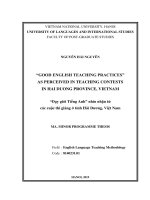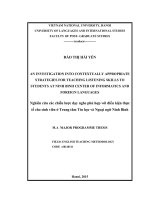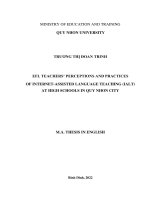MathAna teaching
Bạn đang xem bản rút gọn của tài liệu. Xem và tải ngay bản đầy đủ của tài liệu tại đây (3.85 MB, 7 trang )
Complete Each Math Analogy
1}
D
o :():: :
••
..•
• . < '.
....
'
.
•.
•
BEGINNING
Building Problem-Solving Skills
Series Titles
Math Analogies
Beginning· Book 1 • Book 2
Written by
Linda Brumbaugh and Doug Brumbaugh
Graphic Design by
Trisha Dreyer·
Karla Garrett • Annette Langenstein
â2009
THE CRITICAL THINKING CO.TM
www.CriticaIThinking.com
Phone: 800-458-4849 ã Fax: 831-393-3277
P.O. Box 1610· Seaside· CA 93955-1610
ISBN 978-1-60144-196-6
The individual who initially purchased this product is licensed to reproduce (print or duplicate) the activity pages in this product for use
within one home or one classroom. Our copyright and this reproduction permission prohibit any sale of reproduced pages. No reproduction
permission is granted to any organization or commercial entity without the expressed written permission of The Critical Thinking Co. ™
Printed in the United States of America by McNaughton & Gunn, Inc., Saline, MI (Dec. 2009)
Math Analogies Beginning
Teaching Suggestions
Teaching Suggestions
Analogies occur in life and frequently in high-stakes tests. Understanding analogies and the ability
to reason analogically (reasoning used to identify, evaluate, and solve an analogy) are also important
problem-solving skills. It is, therefore, beneficial for students to learn about analogies as soon as
reasonably possible.
The immediate benefit is to recognize and solve simple analogies. The long-term benefits are improved
reasoning skills that enable students to break problems into their component parts, recognize analogies
imbedded in arguments, and evaluate them.
Problem-solving is an essential part of mathematical development. Analogies provide practice in
breaking math problems down into their component parts, making it easier to recognize familiar formats
that enable students to produce solutions.
Analogical reasoning is not easy, particularly for younger students whose thinking skills are in the
formative stages of development. At this age, children commonly use guesswork instead of organized
analysis to solve problems. For example, ask young children for two numbers between 10 and 15 and
they will often guess or start counting from 1 to find the answer.
A challenge for young students learning to solve analogies is reading the format. For example, "A is to
a as B is to" is not common language for a youngster. The interpretation skills mandate the realization
that the phrase "is to" implies a connection between the. item to the left and right of the phrase. Then,
the word "as" relays the idea that there is a similar connection between the next two items, only one of
which is provided.
On pages iv and v, we provide introductory lessons to help students read and understand analogies.
We encourage teachers to work one-on-one with K-1 students through this lesson and then monitor
student work until it is clear the student grasps the meaning of an analogy.
We recommend that students draw and verbalize their answers. The drawing develops fine motor skills
and the verbalization develops communication skills. Some young children may find drawing answers
too challenging, but might be able to verbalize solutions. At this age, that is fine. However, these
children should be encouraged to attempt to draw the solution after they verbalize it. Remember to
keep learning fun.
The beauty of many of the items presented here is that they are language independent. Thus, nonnative English-speaking students have the opportunity to participate with all other students in the
challenges presented. When all students are involved, each one has the opportunity to learn the basics
and beauty of logic and mathematics while developing and strengthening language skills.
The National Council of Teachers of Mathematics defined five content strands that should appear in the
K-12 mathematics curriculum. These five strands are:
Number and Operations
Algebra
Geometry
Measurement
Data Analysis and Probability
The entries in this book are built around grade-appropriate standards for each of those five strands.
While some of the analogies may appear too difficult or too easy for a student, there will be other
related entries that should be suitable. If the analogies in this book become too easy for the student, try
the next level, which is more challenging.
"Remember to keep learning fun,"
ii
â 2009 The Critical Thinking Co.
ã www.CriticaIThinking.com
ã 800-458-4849
Math Analogies Beginning
Table of Contents
Table of Contents
INTRODUCTION
Teaching Suggestions
Sample Lessons
About the Authors
ii
iv-v
vi
EXERCISES
1-38
NCTM Standards (National Council of Teachers of Mathematics)
Number and
Operations
1,4, 7, 12, 15, 17, 23, 26, 30, 32, 34, 37, 39,44, 46, 50, 52,
55, 56, 58, 60, 63, 65, 67, 70, 74, 76, 81, 83, 86, 92, 98, 102,
106, 110, 114, 118, 122, 126, 129, 132, 135, 139, 143, 146, 149
Algebra
2, 3, 5, 8, 13, 16, 18,22, 24, 27, 31, 33, 35, 38, 40, 45, 47, 51,
53, 57, 59, 61, 66, 68, 71, 75, 77, 82, 84, 87, 89, 91, 93, 95,
97,99,101,103,
105, 1(~7, 109, 111, 113, 115, 117, 119, 121,
123, 125, 127, 130, 133, 136, 140, 145, 147, 150
Geometry
6, 9, 10, 14, 19, 25, 28, 36, 41, 48, 54, 62, 69, 72, 78, 85, 88,
94,104,108,112,120,128,131,141,144,148
Measurement
11, 20, 21, 29, 42, 49, 64, 73, 79, 90, 96, 116, 124, 134, 138,
142, 145, 151
Data Analysis
and Probability
43, 80, 100, 137, 152
ANSWERS
© 2009 The Critical Thinking Co. ™ • www.CriticaIThinking.com
39
• 800-458-4849
iii
Sample Lessons
Math Analogies Beginning
Math Analogy Sample Lessons
Teacher:
"The first girl is smiling. The
second girl is frowning."
•
•
Teacher:
"This circle
is white."
iv
"This circle
is black."
"To make these boys match
the girls, what should the
second boy look like?"
••
•
•
••
"To make
the squares
match the
circles, what
do we have
to do to this
square?"
© 2009 The Critical Thinking Co. ™
• www.CriticaIThinking.com
• 800-458-4849
Math Analogies Beginning
Sample Lessons
Teacher:
"This boy is
"This boy is
pointing up." pointing down."
"To make the arrows
match the boys,
where should the
next arrow point,
up or down?"
••
•
•
••
Teacher:
"To make the two circles match
the two girls, what should the
next circle look like?"
"The first girl is big. The
second girl is smaiL"
ã
ã
â 2009 The Critical Thinking Co.
ã
ã
ãã
ãã
ã www.CriticaIThinking.com
ã 800-458-4849
v
Math Analogies Beginning
About the Authors
About the Authors
Linda S. Brumbaugh
I retired after teaching a total of 31 years in grades three, four, and five. Both my BS from
the University of Florida and Masters from the University of Central Florida are in Elementary
Education. As I look back over my teaching career, I enjoyed seeing the excitement on the
children's faces as they encountered new concepts, worked with a manipulative, experienced
some new mathematical application, or played a new mathematical game. It was stimulating
when they solved an intricate problem, discovered something new to them, or got caught up in
some new mathematical trick. As they got excited about learning, so did I. Each day of every
year brought some new learning opportunity for me and for the children. I continue to work with
pre-school and elementary-age children in the Sunday school system of our church. Our intent
is to convey some of that excitement to each child who uses this book.
Douglas K. Brumbaugh
I taught close to 50 years before retiring after 35 years at the University of Central Florida. I taught
in a variety of settings: college, in-service and almost daily in a K-12 setting. I received my BS
from Adrian College and my Masters and Doctorate in Mathematics Education at the University
of Georgia. Students change, classroom environments change, the curriculum changes, and
I change. The thoughts and examples used here are based on my teaching experiences over
the years. Our hope is that the thoughts in this book will spark the mathematical interest of each
child who works with them.
vi
© 2009 The Critical Thinking Co. ™
• www.CriticaIThinking.com
• 800-458-4849





